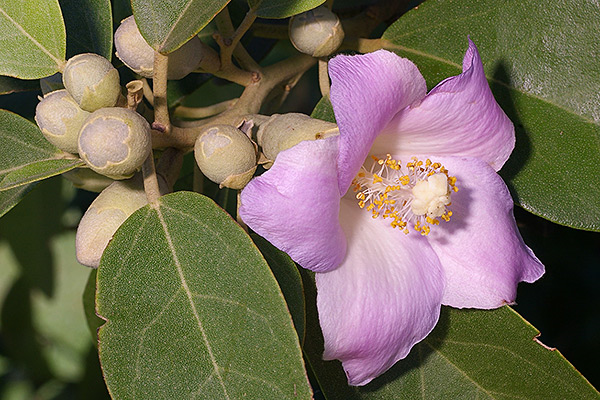General Description:
Lagunaria is a small genus of two species; L.patersonia, which occurs on Norfolk and Lord Howe Islands and L.queenslandica from north-east Queensland. The latter was previously regarded as L.patersonia subsp. bracteata but has been raised to species status on the basis of morphological and ecological differences. L.patersonia also is more robust in habit and has larger, scaly leaves. The two species also differ in their habitats with L.patersonia generally occurring in rainforest while L.queenslandica is found in non-rainforest areas often along rivers and creeks.
Lagunaria patersonia is well known in cultivation both in Australia and overseas. On mainland Australia it has apparently become naturalised in a number of areas such as the central coast and north-eastern areas of New South Wales.
Note that there appears to be some confusion as to the specific name; patersonius, patersonia, patersoni and patersonii have all been applied but patersonia is the accepted form in the Australian Plant Census.
Norfolk Island hibiscus is a medium to large tree which can reach about 12-20 metres in height. It has dense, greyish-green leaves which are oval shaped to about 100 mm long and covered in soft hairs when young. The pink flowers are of typical hibiscus shape and appear in the leaf axils in spring and early summer. They are generally a pink to mauve but deeper coloured forms are in cultivation. The flowers are followed by brown capsules containing a number of black seeds. The capsules contain white fibres, which are can be very irritating if they get on the skin. These give rise to other common names for the plant such as Itch Tree and Cow Itch Tree.
Norfolk Island hibiscus has proven to be an adaptable and hardy plant for a range of climates and soils. It is widely grown in tropical, sub-tropical and temperate areas of both coast and inland. It is hardy to salt spay and is therefor excellent for coastal gardens. It performs best in well drained soils in a sunny position.
Propagation from seed is relatively easy. No special pretreatment is needed but care needs to be taken in removing seed from the capsules so that the irritant fibres do not come in contact with the skin. Cuttings also strike readily.

Lagunaria patersonia
Photo: Brian Walters
 Australian Native Plants Society (Australia)
Australian Native Plants Society (Australia)